Current Electricity
Introduction to Electricity
Importance of Electricity:
- We use electricity daily for appliances like fridges, fans, washing machines, etc.
- Industries use it for motors and furnaces.
- Hospitals, banks, and offices use generators to avoid power cuts.
- Even some animals, like eels, use electricity for hunting or defense.
- Lightning is a natural form of electricity.
Flow of Electricity:
- Electricity flows like water-from a higher level to a lower level.
- Example: Water flows from a dam at a higher level to a lower level due to gravity.
Potential and Potential Difference
Electric Potential:
- It’s like the “level” of electric charge at a point, similar to the height of water.
- Positive charges flow from higher potential to lower potential.
- Electrons (negative charges) flow from lower potential to higher potential.
Potential Difference:
- The difference in potential between two points (A and B).
- It causes the flow of electrons.
- Example: In a circuit, electrons flow from the negative terminal (lower potential) to the positive terminal (higher potential) of a cell until the potential difference becomes zero.
Activity (Figure 3.1):
- Two bottles connected by a tube with a clamp:
- When the clamp is removed, water flows from the higher bottle to the lower one.
- Water stops when levels are equal.
- To keep it flowing longer, maintain a height difference (like potential difference in electricity).
Potential Difference of a Cell:
- It’s the difference between the positive and negative terminals of a cell.
- Caused by chemical reactions inside the cell.
- Formula: Potential Difference (V) = Work Done (W) / Charge (Q).
- Unit: Volt (V). 1 V = 1 J / 1 C (1 Joule of work to move 1 Coulomb of charge).
Free Electrons and Current
Free Electrons:
- In metals, outermost electrons are weakly attached to atoms and can move freely (called free electrons).
- These electrons carry negative charge in a conductor.
Flow of Electrons:
- Without a cell, electrons move randomly in a wire (no current).
- When connected to a cell, electrons move from the negative terminal (lower potential) to the positive terminal (higher potential), creating a current.
- Conventional current direction: Positive to negative (opposite to electron flow).
Electric Current (I):
- The flow of electrons through a conductor.
- Formula: I = Q / t (Charge / Time).
- Unit: Ampere (A). 1 A = 1 C / 1 s (1 Coulomb per second).
- Smaller units:
- 1 mA (milliampere) = 10⁻³ A.
- 1 μA (microampere) = 10⁻⁶ A.
- Example: If 0.4 A flows for 5 minutes (300 s), charge (Q) = I × t = 0.4 × 300 = 120 C.
Resistance and Ohm’s Law
Resistance (R):
- It’s the opposition to the flow of electrons in a conductor.
- Electrons collide with atoms/ions, causing resistance.
- Unit: Ohm (Ω).
Ohm’s Law:
- At a constant temperature, the current (I) through a conductor is directly proportional to the potential difference (V) across it.
- Formula: V = I × R (or R = V / I).
- 1 Ω = 1 V / 1 A (resistance when 1 A flows with 1 V applied).
- Example: A bulb with R = 1000 Ω and V = 230 V has I = V / R = 230 / 1000 = 0.23 A.
Resistivity (ρ):
- Resistance depends on:
- Length (L): R ∝ L (longer wire, more resistance).
- Area of cross-section (A): R ∝ 1/A (thicker wire, less resistance).
- Material of the wire.
- Formula: R = ρ × (L / A).
- ρ (resistivity) is a property of the material.
- Unit of ρ: Ohm-meter (Ωm).
- Example: Copper (ρ = 1.7 × 10⁻⁸ Ωm), Nichrome (ρ = 1.1 × 10⁻⁶ Ωm), Diamond (very high).
- Example: A wire (L = 50 cm, r = 0.5 mm, R = 30 Ω) has ρ = (R × A) / L = 4.71 × 10⁻⁵ Ωm.
Activity (Ohm’s Law Verification, Figure 3.7):
- Use a nichrome wire, cells, ammeter, and voltmeter.
- Increase the number of cells (1 to 4) and measure V and I.
- Calculate R = V / I for each case.
- Plot a V vs. I graph-it’s a straight line, proving Ohm’s Law (V ∝ I).
Conductors and Insulators
Conductors:
- Materials with low resistance, allowing easy current flow.
- Examples: Copper, aluminum (used in wires).
Insulators:
- Materials with very high resistance, blocking current flow.
- Examples: Rubber, glass (used for safety).
Activity (Figure 3.6):
- Test materials (copper, aluminum, glass, rubber) in a circuit.
- Conductors (copper, aluminum) show high current; insulators (glass, rubber) show no current.
Why Do Some Conduct?
- Conductors have many free electrons; insulators have few or none.
- Our body conducts because it contains water with ions (charged particles).
Electric Circuit
What is a Circuit?
- A continuous path for current flow, including a cell, wires, and resistors.
- Circuit Diagram: A drawing using symbols to show connections.
Components (Figure 3.5):
- Ammeter: Measures current (connected in series).
- Voltmeter: Measures potential difference (connected in parallel).
- Resistance: Opposes current.
- Cell: Provides potential difference.
- Key/Switch: Opens or closes the circuit.
Resistors in Series
Series Connection (Figure 3.8):
- Resistors are connected end-to-end (one after another).
- Same current (I) flows through each resistor.
- Total potential difference (V) = V₁ + V₂ + V₃.
- Effective resistance (Rₛ): Rₛ = R₁ + R₂ + R₃ + … + Rₙ.
- Features:
- Total resistance increases (sum of all resistances).
- If one resistor fails, the circuit breaks (e.g., bulbs in series dim or stop).
- Example: R₁ = 15 Ω, R₂ = 3 Ω, R₃ = 4 Ω → Rₛ = 15 + 3 + 4 = 22 Ω.
- Example: R₁ = 16 Ω, R₂ = 14 Ω, V = 18 V → Rₛ = 30 Ω, I = 18 / 30 = 0.6 A, V₁ = 9.6 V, V₂ = 8.4 V.
Resistors in Parallel
Parallel Connection (Figure 3.9):
- Resistors are connected side by side (same ends connected).
- Total current (I) = I₁ + I₂ + I₃.
- Potential difference (V) is the same across all resistors.
- Effective resistance (Rₚ): 1/Rₚ = 1/R₁ + 1/R₂ + 1/R₃ + … + 1/Rₙ.
Features:
- Total resistance decreases (less than the smallest resistance).
- If one resistor fails, others still work (current finds another path).
- Bulbs in parallel shine equally bright.
- Example: R₁ = 15 Ω, R₂ = 20 Ω, R₃ = 10 Ω → 1/Rₚ = 1/15 + 1/20 + 1/10 = 13/60 → Rₚ = 60/13 ≈ 4.615 Ω.
- Example: R₁ = 5 Ω, R₂ = 10 Ω, R₃ = 30 Ω, V = 12 V → I₁ = 2.4 A, I₂ = 1.2 A, I₃ = 0.4 A, I = 4 A, Rₚ = 3 Ω.
Domestic Electrical Connections
Wiring at Home:
- Three wires:
- Live wire (red/brown): Brings current (220 V in India).
- Neutral wire (blue/black): Returns current.
- Earth wire (green/yellow): For safety, connected to the ground.
- Appliances are connected in parallel:
- Each gets the same voltage (220 V).
- If one fails, others still work.
Fuse Wire:
- Protects appliances by melting if current is too high.
- Made of a material with a low melting point.
- Common ratings: 1 A, 2 A, 5 A, etc.
Safety Precautions:
- Keep switches/sockets out of children’s reach.
- Don’t touch appliances with wet hands; use rubber soles.
- If someone gets a shock, don’t touch them-turn off the main switch or use a wooden stick to move them.

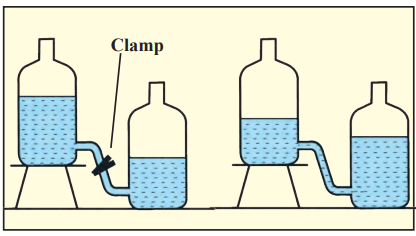
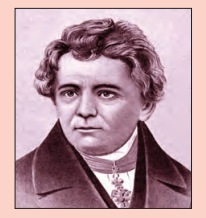
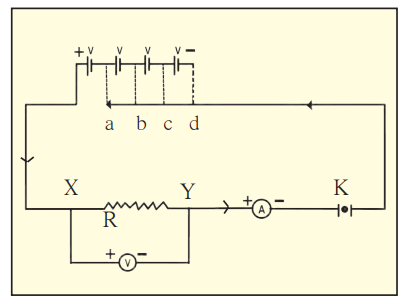
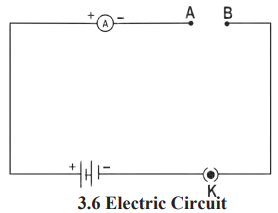
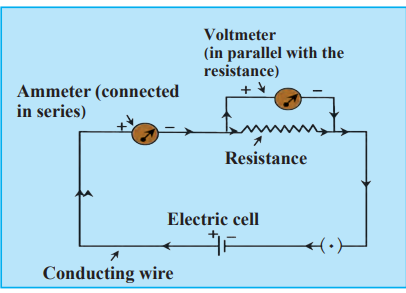

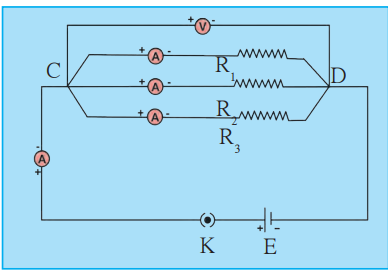
Leave a Reply